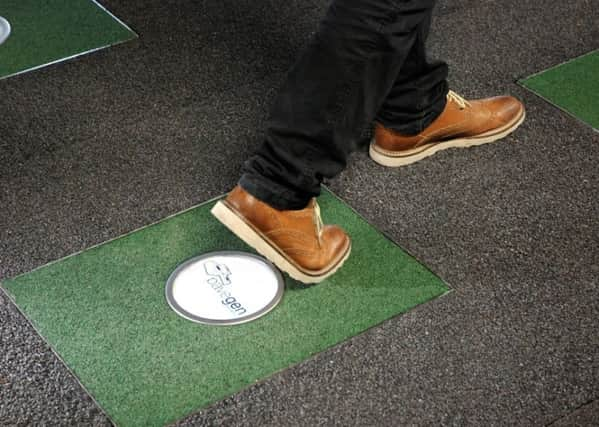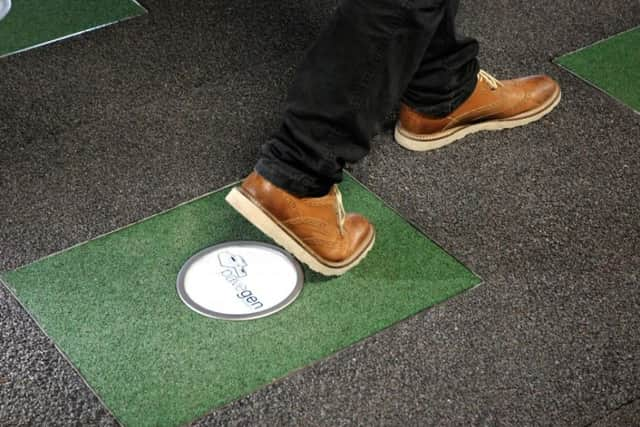Footstep power project to be launched in Scotland


Pavegen is due to arrive north of the border at a major sporting arena within the next few months.
Laurence Kemball-Cook, 29, founder of Pavegen, said the development of the project - at an undisclosed venue - was in its final stages.
Advertisement
Hide AdAdvertisement
Hide Ad“I can’t say too much about it due to confidentiality but this will be our largest project in Scotland,” Mr Kemball-Cook said.


Pavegen uses floor tiles fitted with tiny generators and batteries to store and convert wasted kinetic energy harnessed from every step taken.
Around seven watts of electricity will be captured from each step, with 10 tiles enough to power a street light through the night, Mr Kemball-Cook said.
Pavegen has been installed in over 100 projects in more than 30 countries, in train stations,
shopping centres, airports and public spaces.


At London Heathrow’s Terminal 3, 51 tiles power the LED lights in a key corridor while at London Zoo the technology lights up the tiger enclosure.
It is also used in Harrods department store and several offices at London Bridge and in The City.
The largest Pavegen installation in the world is in the Morro da Mineira favela in Rio de Janeiro.
Here, the Pavegen tiles work alongside solar panels to power the lights for up to 10 hours on a full battery.
Advertisement
Hide AdAdvertisement
Hide AdIt is now hailed as the world’s first ever people-powered football pitch and was officially opened on football legend Pelé last year.
Me Kemball-Cook worked with the Shell Livewire programme, which supports innovation in science, engineering and technology, to get the pitch in place.
He said: “Its given young people a safe place to play at night at it is making a huge difference to the community.”
Mr Kemball-Cook added: “We want to be the intel inside the cities of the future.
“Solar has been in development for over 65 years, originally the price was in the thousands of dollars for a kilowatt and now it costs just a few cents.
“We have achieved the first 20 years of solar development over the past 5 years with the Pavegen technology”
He said he was now setting out to make the floor tiles as cheap as other flooring.
Mr Kemball-Cook, an industrial engineer, came up with the idea of footfall power after trying to devise a solar-powered street light.
Advertisement
Hide AdAdvertisement
Hide AdWith Pavegen first sketched out on a napkin, Mr Kemball Cook sought out investors and support for his project.
He said: “I went to 150 venture capitalists and they said no, I went to government and they said ‘no, it will never work’ and I went back to Loughborough University where I studied and they said ‘give us your company and we will help you.”
After deciding to go it on his own, Mr Kemball-Cook spent two years in his flat in Brixton developing Pavegen.
After raising around £350,000 in capital, some from family and friends, Mr Kemball-Cook was able to go into batch production in 2011.
This year, he raised £2m through a crowd funding platform in just 45 days with Pavegen now having 2,000 shareholders.
“We started from scratch with a sketch on a napkin...and we have shown through business nous and the technology that Pavegen is a game changer.”
Innovation such as Pavegen is regarded as central to Scotland meeting its carbon cutting targets and making cities cleaner and smarter.
A report for the Scotland’s Way Ahead taskforce said other projects including solar roads - which could help to power electric cars - and the creation of biofuels from waste produced by the whisky industry could also make a valuable contribution to Scotland’s green credentials.
Advertisement
Hide AdAdvertisement
Hide AdThe taskforce -made up of experts in sustainability, finance, law, planning and engineering - is now considering a longlist of 10 projects - including high speed rail and district heating networks - that could impact on Scotland’s ability to meet its climate change commitments.
Scotland is making faster progress on cutting emissions than the UK as a whole but the Scottish Government has failed to meet its first four annual targets.
Dr Sam Gardner, Head of Policy at WWF Scotland said the need to tackle climate change was driving innovation such as Pavegen.
He added: “The simplicity of this technology is its beauty, by simply walking on these pavement we will reduce emissions and generate clean energy.
“Research from the Global Commission on Economy and Climate has shown that if we invest in smart, low carbon cities the world could enjoy savings of $22 trillion by 2050. Low carbon infrastructure is needed to ensure we play our part in tackling climate change while also building a better, cleaner, healthier future.